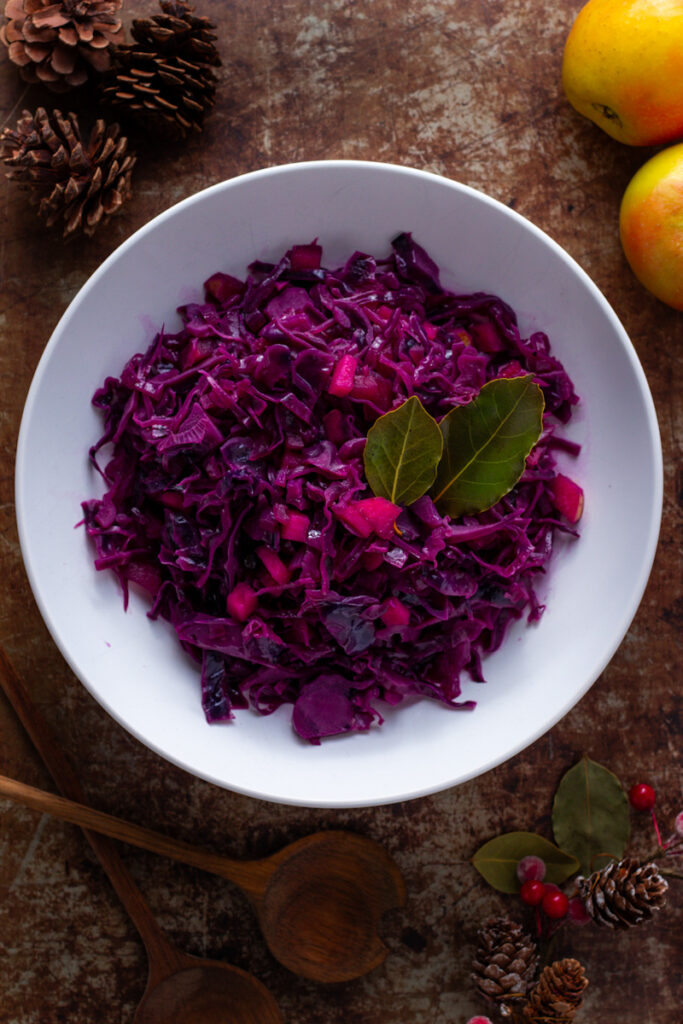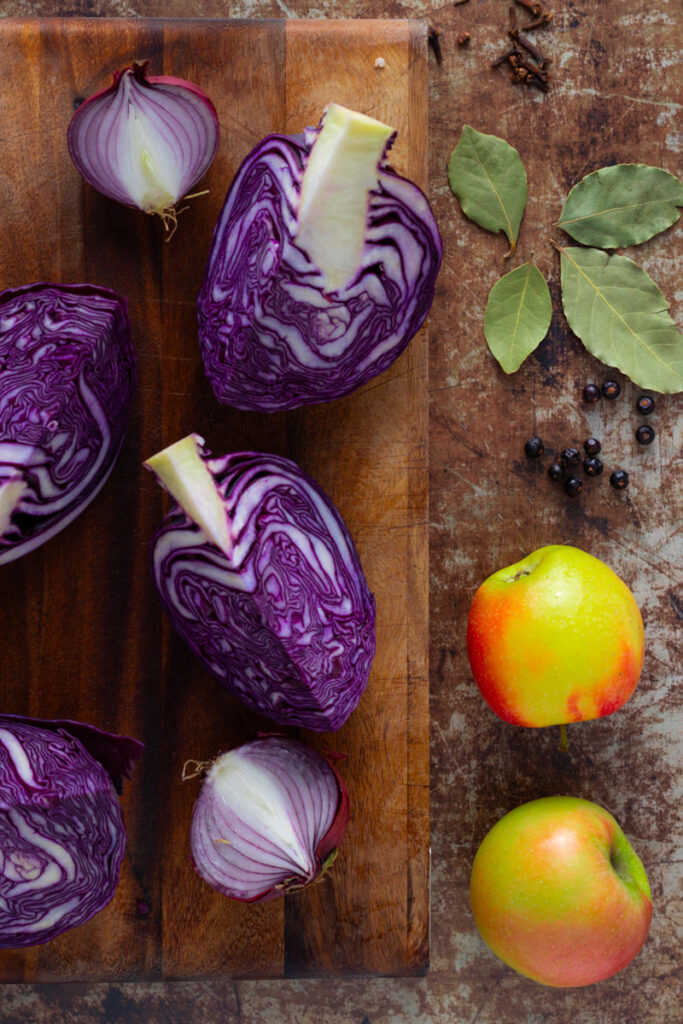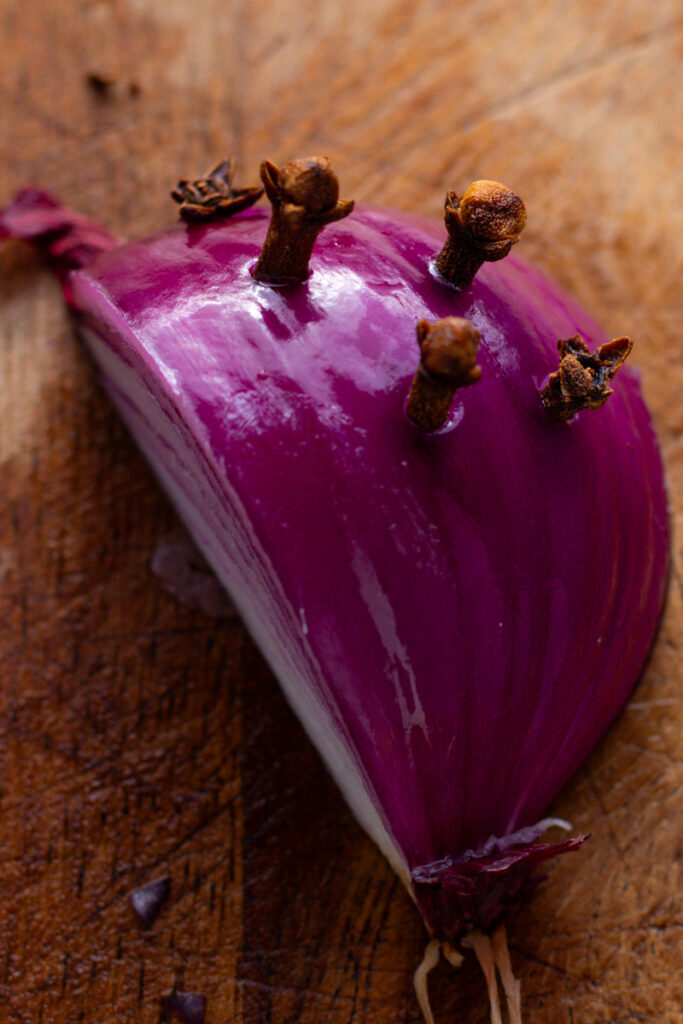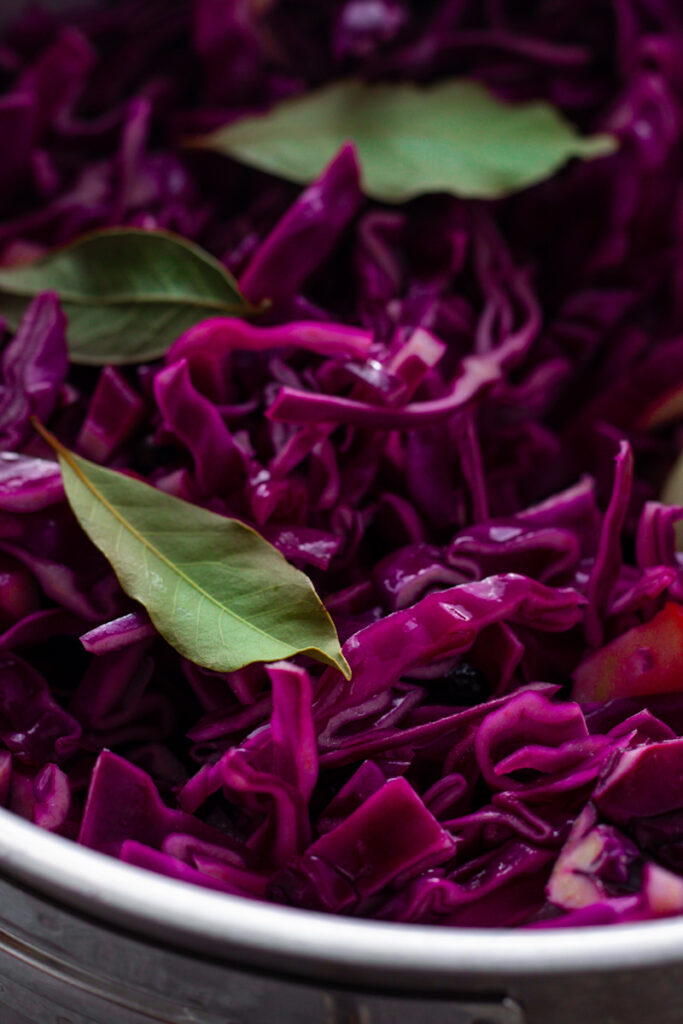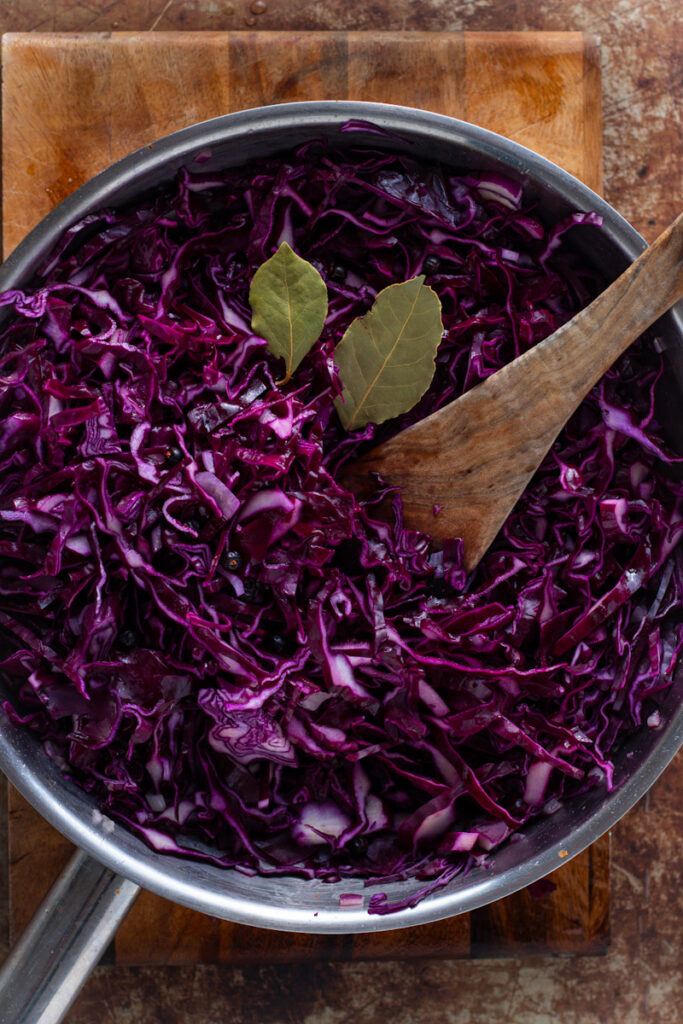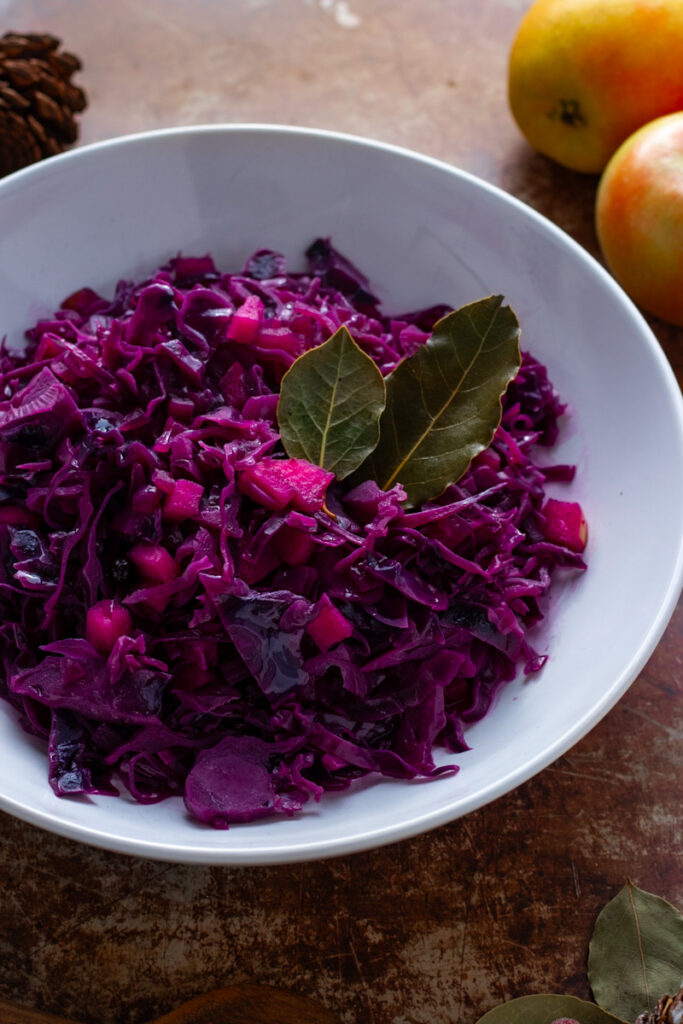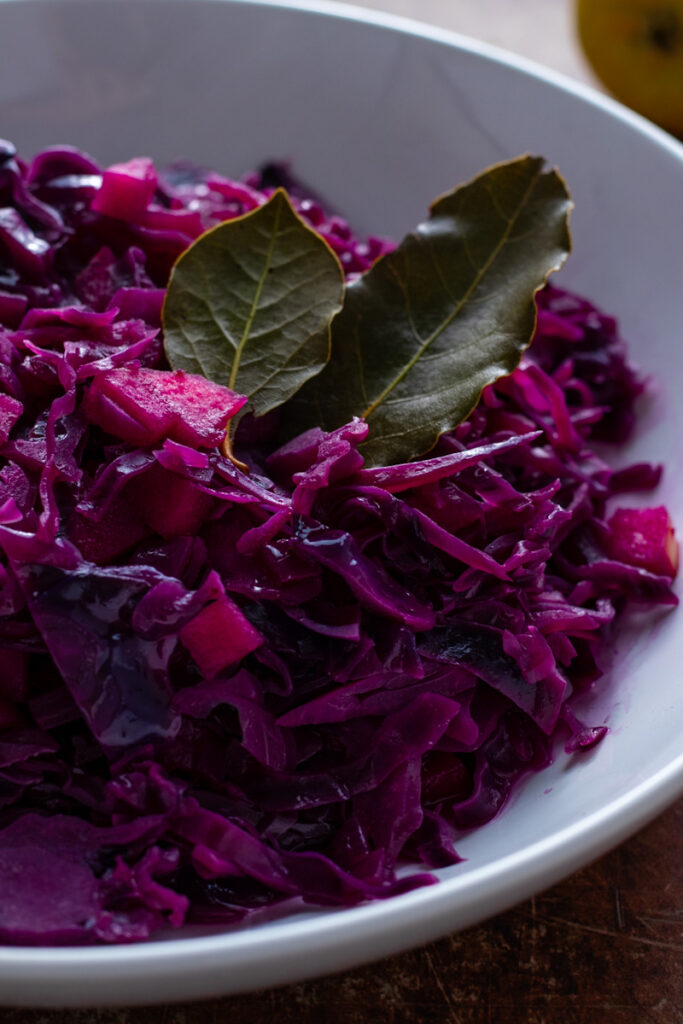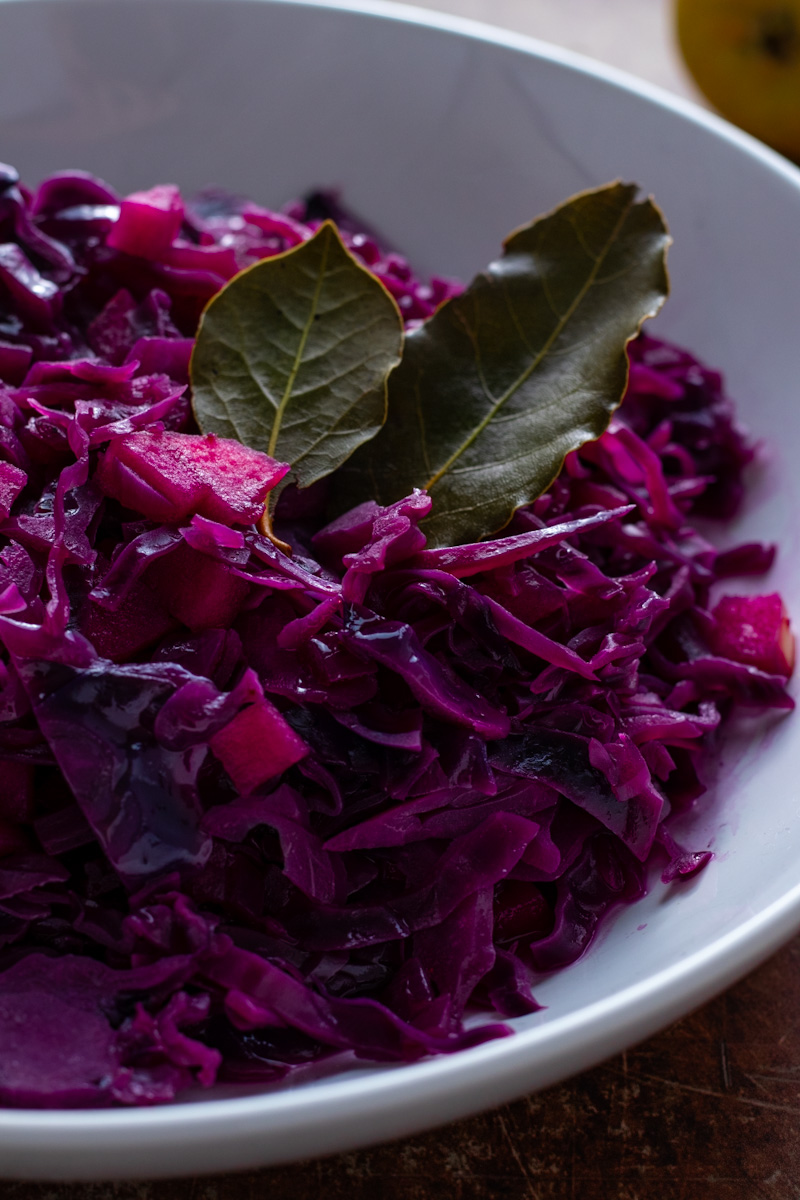
German Braised Red Cabbage (Blaukraut)
No festive table in Germany would be without a big pot of braised red cabbage, flavoured with apple, cloves and juniper berries. Depending on where in the country you are, this could be called Rotkohl or Blaukraut and it is the perfect accompaniment to roast goose.
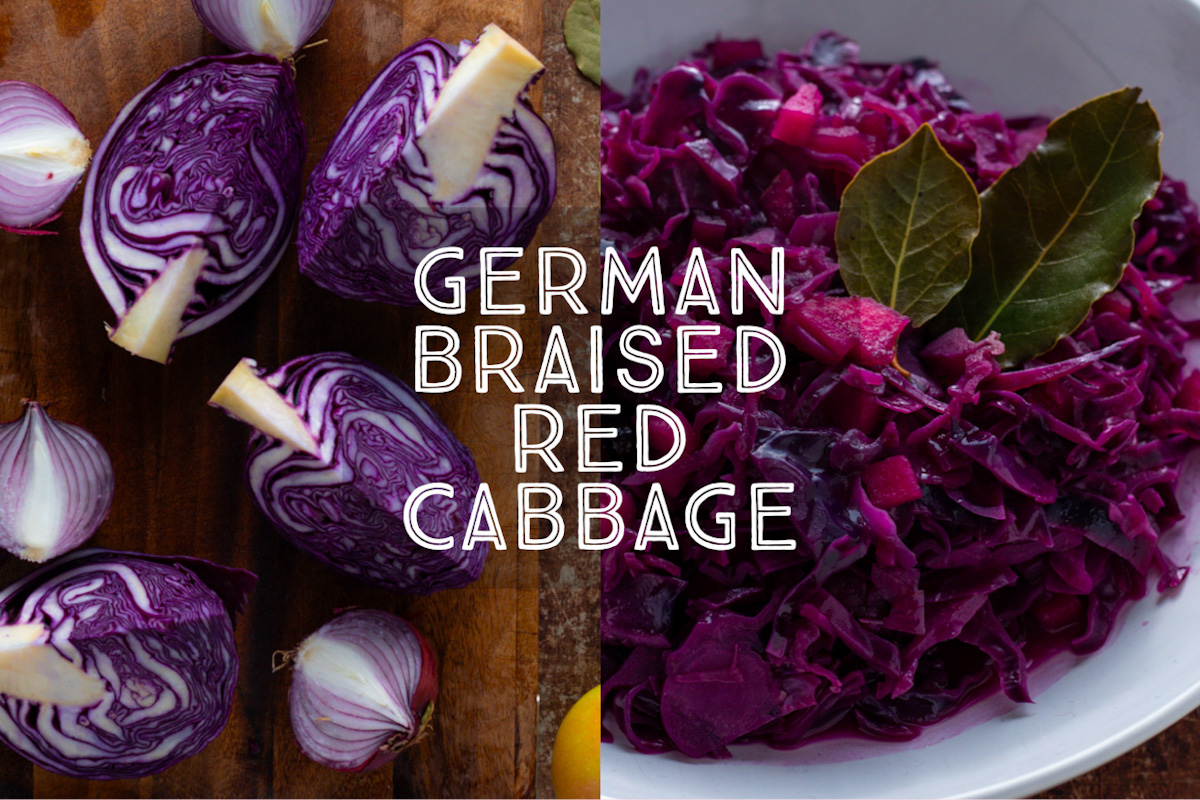
Christmas is coming ever closer, and here in Germany we’re not just baking cookies, we are also starting to prepare for the seasonal feasts.
A dish guaranteed to be served all over the country at this time of year is braised red cabbage: Rotkohl or Blaukraut.
TABLE OF CONTENTS
▼
Gently spiced with fragrant cloves, juniper berries and bay leaf, and sweetened with apple and redcurrant, this traditional recipe is the perfect side dish for roast goose or Sauerbraten.
Rotkohl vs. Blaukraut
Why does this dish have two different names? Well, it all depends on where in Germany you are! In the North they call red cabbage ‘Rotkohl’ which means the same as in English, red cabbage.
Here in Bavaria we call braised red cabbage ‘Blaukraut’ or blue cabbage! In fact the dish is really a sort of violet purple, so a mix of red and blue.
Depending on the exact ingredients added the dish can be more one colour than the other. We may not agree on the name, but we all agree how tasty it is!
Ingredients
To make my traditional German Red Cabbage recipe, you’ll need the following main ingredients:
- Red Cabbage: The star of the show! To make a reasonably big portion of Blaukraut, you only need a small head of cabbage, around 750g /1.75 lb. PRO TIP: To. Stop the cabbage staining your hands, either rub a little oil on your hands before slicing, or wear a pair of gloves.
- Apple: I always use tart apples when I cook Blaukraut, it adds a lovely sour note. Adding it later in the cooking process means that you get tasty little chunks of apple throughout the dish and it doesn’t break apart during the braising time.
- Onions: I use red onions to assist with the beautiful violet hue of this dish, but you can use brown or yellow onions.
- Redcurrant Jelly: Redcurrant jelly sweetens and adds a tanginess to this dish. It’s not traditional, but you can use a good quality cranberry jelly instead with similar results.
- Spices: Rotkohl or Blaukraut is commonly spiced with juniper berries, bay leaves and whole cloves. COOKS TIP: Pressing the cloves into a slice of onion means you can remove them easily at the end of the cooking time.
- Vinegar and wine: a dash of apple vinegar and red wine add flavour and balance to this dish. You can also use red wine vinegar.
The complete ingredient list and detailed instructions are in the recipe card at the bottom of the page.
Frequently Asked Questions
Do I have to thicken the sauce when baking braised cabbage?
Nope, that is entirely up to you. I prefer thicker sauces, but it will taste great whichever way you decide.
How long will braised red cabbage keep?
A long time! At least a week or more in an airtight container in the fridge. You can also freeze or can it if you’d like to keep it longer.
Can I braise red cabbage without wine?
Of course! Just replace it with a little apple juice and vinegar.
Braised Red Cabbage goes well with…
Blaukraut is a classic side dish to serve with lots of German recipes like a classic German-style roast goose, Sauerbraten, pork roast or pork chops.
It’s also delicious with meats like venison and roast duck. Of course, you’ll need some Potato Dumplings too!
German Braised Red Cabbage (Blaukraut)
No festive table in Germany would be without a big pot of braised red cabbage, flavoured with apple, cloves and juniper berries. Depending on where in the country you are, this could be called Rotkohl or Blaukraut and it is the perfect accompaniment to roast goose.
Ingredients
- 1 small red cabbage, around 750g (1.75 lb.)
- 2 medium red onions
- 5 cloves
- 1 Tbsp butter
- 2 Tbsp apple cider vinegar
- 3 Tbsp redcurrant jelly or cranberry jelly
- 3 bay leaves
- 1 tsp juniper berries
- 500 ml 2 cups vegetable stock or broth
- Splash of red wine
- 2 medium apples
- Sea salt and black pepper
optional:
- 1 Tbsp cornstarch
Instructions
- PREPARE: Wash the cabbage, cut into quarters and cut out the white stem. Remove the outer leaves, then slice finely. Peel the onions and dice finely, reserving a quarter of one onion (not diced!). Push the cloves into the reserved onion (this way they won’t get lost).
- SAUTÉ VEGETABLES: Heat the butter in a large, deep-sided skillet (it needs a lid) and gently cook the diced onion until soft, but not coloured. Add the red cabbage and the vinegar and immediately stir well to combine.
- SIMMER: Stir through the redcurrant jelly, bay leaves, juniper berries, stock and red wine, tuck the onion slice with the cloves into the pan, season well with salt and pepper, then cover and simmer over medium heat for 20 minutes.
- ADD APPLES: While the cabbage is cooking, peel, core and dice the apples. After 20 minutes, add them to the pan and cook, covered, for a further 15 minutes until the cabbage is tender. The cabbage should still have a bit of bite.
- OPTIONAL: If you’d like the braising liquid to be a little thicker, stir the cornstarch into 3 tablespoons of cold water. When the cabbage is tender, stir the cornstarch slurry into the mixture, bring to the simmer once more, stirring until thickened, then remove from the heat.
- SERVE: Discard the onion with the cloves, taste and season with a little salt, pepper, sugar or more redcurrant jelly to taste, then serve warm or hot alongside roast meats.
Notes
Rotkohl or Blaukraut can be made well in advance, and in tastes even better the next day when the flavours have really developed. Simply reheat over low heat in a saucepan with a splash of water or apple juice to loosen before serving.
I prefer to use a sharp knife to slice my cabbage, but you can, of course, use a food processor with a slicing attachment fitted if you prefer
As an Amazon Associate and member of other affiliate programs, I earn from qualifying purchases.
Nutrition
Serving: 1g | Calories: 227kcal | Carbohydrates: 47g | Protein: 5g | Fat: 3g | Saturated Fat: 2g | Polyunsaturated Fat: 1g | Cholesterol: 7mg | Sodium: 224mg | Fiber: 7g | Sugar: 30g
Tried this recipe?I’d love to hear how it went! Please leave a review or a star rating and let me know how it was! Use the hashtag #daysofjay on Instagram so I can see your delicious creations.

About the Author
Jay Wadams is a cookbook author, food photographer, and graduate of Le Cordon Bleu in Gastronomy and Nutrition.
Based in Italy 🇮🇹 Germany 🇩🇪 and Australia 🇦🇺.


